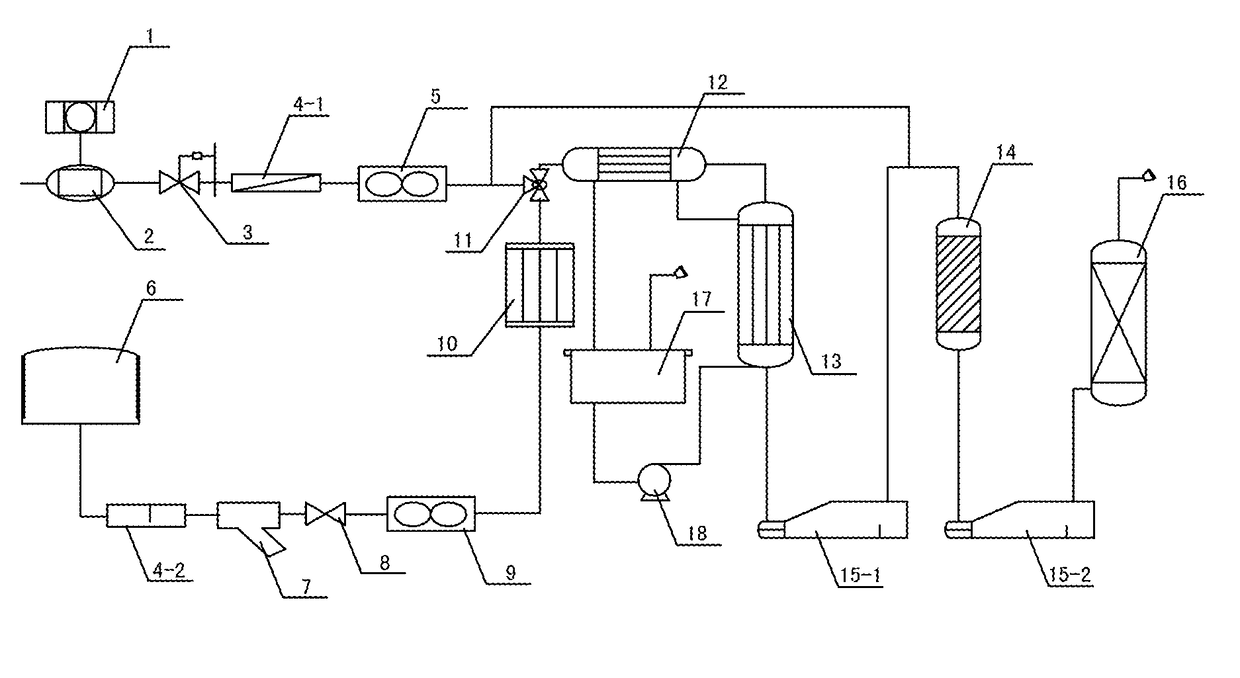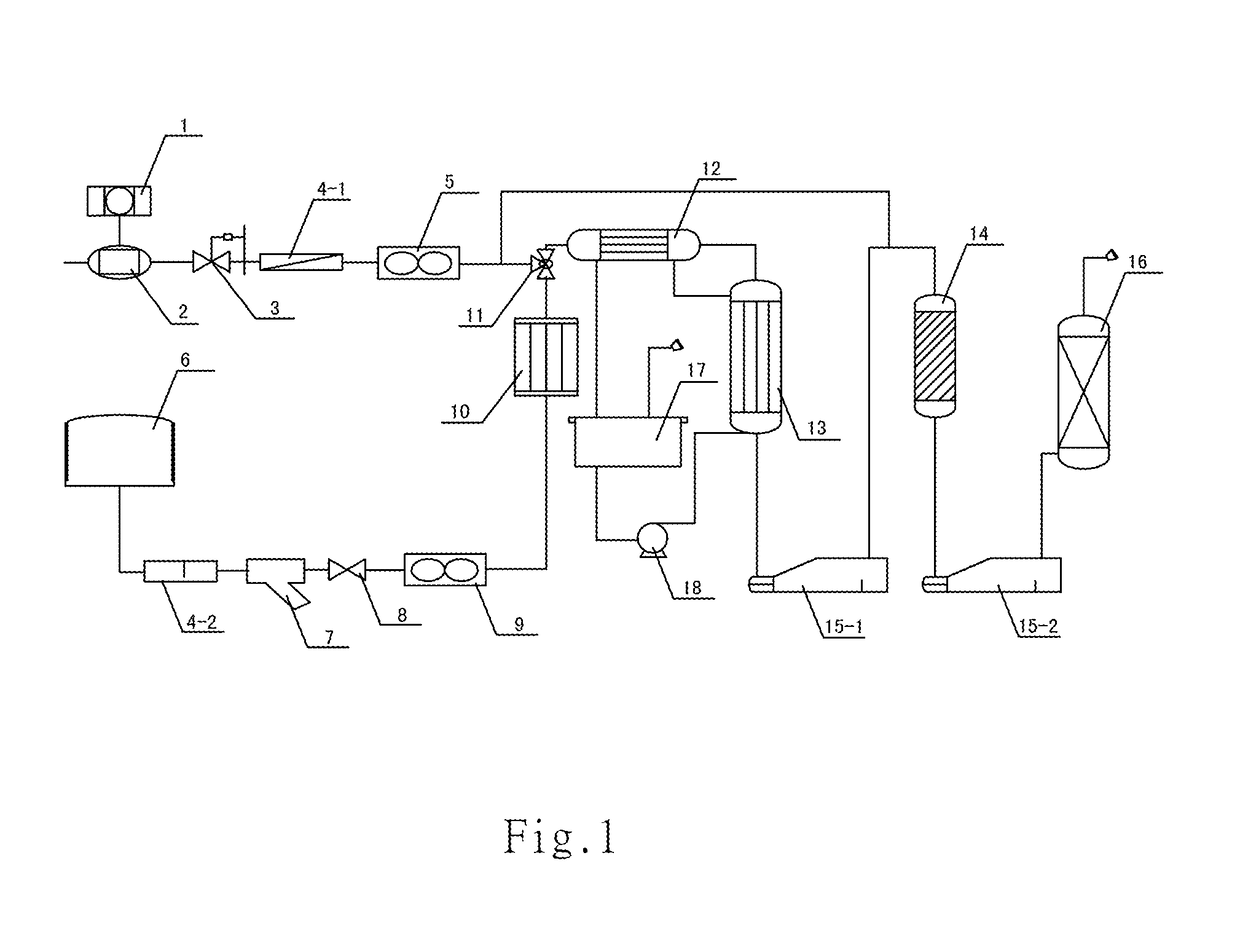Catalyst for selectively catalytically oxidizing hydrogen sulfide, catalyst for burning tail-gas, and process for deeply catalytically oxidizing hydrogen sulfide to element sulfur
a catalytically oxidizing hydrogen sulfide and catalyst technology, applied in the direction of physical/chemical process catalysts, separation processes, sulfur preparation/purification, etc., can solve the problems of high investment and operating costs of the tail-gas dealing unit, unsatisfactory activity of h/sub>2/sub>s and sulfur recovery, and inefficient catalyst selectivity, etc., to achieve the effect of improving the selectivity of catalysts, reducing the total sulfur content of ven
- Summary
- Abstract
- Description
- Claims
- Application Information
AI Technical Summary
Benefits of technology
Problems solved by technology
Method used
Image
Examples
embodiment 1-3
[0035]In the embodiment 1-3, the isothermal reactor adopts catalyst A, B, C for selectively catalytically oxidizing hydrogen sulfide respectively. The evaluation condition parameter of the catalyst activity is listed in chart 1. The activity evaluation data and catalyst composition is listed in chart 2.
[0036]Contrast 1
[0037]In the contrast 1, the isothermal reactor adopts conventional catalyst D. The evaluation condition parameter of the catalyst activity is listed in chart 1. The activity evaluation data and catalyst composition is listed in chart 2.
CHART 1Evaluation condition of the activity of the selective oxidation catalystSpace velocityAcid gas flowVolume of theGranularity of the(based on theafter air is injectedcatalystsamplemixed acid gas)inAir flow8 ml20-40 mesh1500 h−1200 ml / min136 ml / minAcid gas after airResidual oxygenWater content ofSource acid gasis injected incontent in tail-Oxygen content insaturated waterH2S %H2S %gas %air %vapor (40° C.)11.758.45-8.650.14215.8%
CHAR...
embodiment 4-7
[0038]In the embodiment 4-7, the adiabatic reactor adopts tail-gas burning catalyst E, F, G, H. The evaluation condition parameter of the catalyst activity is listed in chart 3. The activity evaluation data and catalyst composition is listed in chart 4.
CHART 3Evaluation condition of the activity of the tail-gas burning catalystSpace velocityVolume of theGranularity of the(based on theAcid gas flow aftercatalystsamplemixed acid gas)air is injected inAir flow8 ml20-40 mesh1500 h−1200 ml / min136 ml / minAcid gas after airResidual oxygenWater content ofSource acid gasis injected incontent in tail-Oxygen content insaturated waterH2S %H2S %gas %air %vapor (40° C.)5.20-5.343.15-3.250.52205.8%
CHART 4Activity evaluation data of the tail-gas burning catalystCompositionEFFe2O3: 48%Fe2O3: 48%GHTiO2: 48%TiO2: 48%Fe2O3: 60%Fe2O3: 78%V2O5: 0.4%V2O5: 0.8%TiO2: 26%TiO2: 18%Tail-gasTemperatureH2S %SO2 %S %H2S %SO2 %S %H2S %SO2 %S %H2S %SO2 %S %180° C.00.252692.10.0.223193.000.235394.100.103296.700.24019...
embodiment 8
[0039]The process for deeply catalytically oxidizing hydrogen sulfide to element sulfur of the present invention adopts an isothermal reactor and an adiabatic reactor connected in series, which are filled with the catalyst for selectively catalytically oxidizing hydrogen sulfide and the catalyst for burning tail-gas respectively for reaction.
[0040]As illustrated in FIG. 1, the air after being filtered by the air filter 1 passes through the air compressor 2, the pressure regulator 3, the first water-vapor separator 4-1, the air flow meter 5 and reaches the gas mixing valve 11; the acid gas from the acid gas storage tank 6 passes through the second water-vapor separator 4-2, the acid gas filter 7, the entrance stop valve 8, the acid gas flow meter 9, the acid gas heat exchanger 10 and reached the gas mixing valvell to blend with air. The mixed gas passed through the mixing heat exchanger 12, the isothermal reactor 13, the first collector 15, the adiabatic reactor 14; the second collec...
PUM
| Property | Measurement | Unit |
|---|---|---|
| mass percent | aaaaa | aaaaa |
| mass percent | aaaaa | aaaaa |
| mass percent | aaaaa | aaaaa |
Abstract
Description
Claims
Application Information
 Login to View More
Login to View More - R&D
- Intellectual Property
- Life Sciences
- Materials
- Tech Scout
- Unparalleled Data Quality
- Higher Quality Content
- 60% Fewer Hallucinations
Browse by: Latest US Patents, China's latest patents, Technical Efficacy Thesaurus, Application Domain, Technology Topic, Popular Technical Reports.
© 2025 PatSnap. All rights reserved.Legal|Privacy policy|Modern Slavery Act Transparency Statement|Sitemap|About US| Contact US: help@patsnap.com


